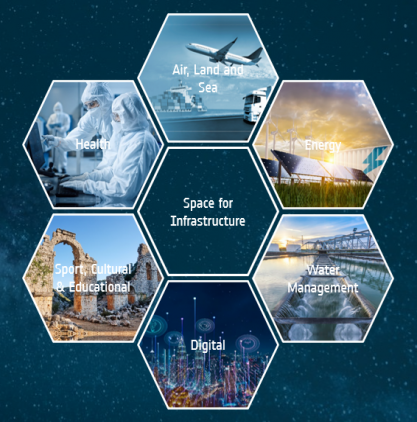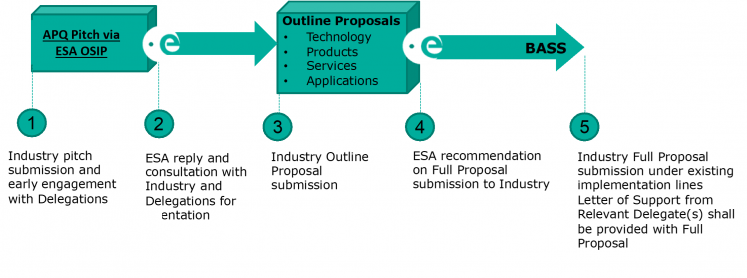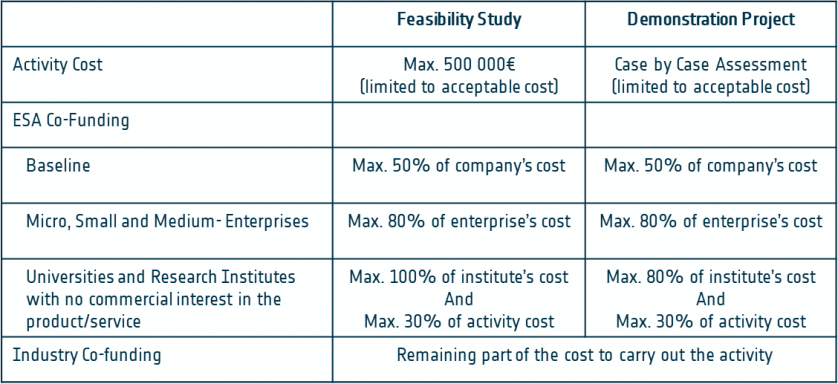***The overarching closing date of 01/12/2024 is tentative***
Sub-themes
This funding call consists of 6 sub-themes, each open at a different point in time. Please see the list of currently open or upcoming funding calls and their further specific details below:
- Sub-theme 1: Air, Land and Sea Transport Infrastructure (open: 17 July 2023 - 24 November 2023).
- Sub-theme 2: Energy (open: 30 October 2023 - 26 January 2024)
- Sub-theme 3: Sport, Culture & Education (open: 31 January - 26 April 2024)
- Sub-theme 4: Water Management (opening: 5 April - 28 June 2024)
- Sub-theme 5: Health (opening: 28 June - 26 September 2024) ** opening and closing dates are tentative **
- Sub-theme 6: Digital Infrastructure
Funding opportunity
Infrastructure underpins both national economies and citizens’ quality of life. It consists of the physical infrastructure needed, for example, to power homes and businesses and to supply the water that people need, but it also includes the digital infrastructure required to manage the transport of goods efficiently, to exchange ideas, and to stay in touch with family and friends. Infrastructure networks account for a substantial proportion of both government and private sector investment and, given its scale, it is critical that such investment is deployed effectively.
A properly functioning and accessible infrastructure is vital for the sustainable economic development of each country. The facilities and services reliant on infrastructure need to be available, accessible, inclusive and beneficial to all. For example, providing dependable and accessible low-emission transport on land, air and sea is critical to achieve net-zero targets, and is widely recognised as being a key contributor to improving livelihoods and economic productivity. Water management is important for supporting industrial utilities. Maintaining a secure and adequate energy supply is fundamental for society and the provision of the services essential for production, communication, and exchange.
The main objectives of the Fixed Call for Proposals for Applications Activities on “Space for Infrastructure” are to:
- Support the infrastructure sector by stimulating the emergence of innovative space applications and services with high market potential.
- Improve efficiency in the selected domains within the infrastructure sector through effecting lower costs, improved capacity management and increased output, whilst reducing environmental footprint.
- Increase the resilience of the infrastructure with more accurate resilience models and reducing the impact of disruptive events.

Value of Space
Satellite technologies and data have a significant role to play within prospective services:
- Satellite Communications (SatCom) enables the provision of ubiquitous connectivity to enhance the communication links, connectivity of IoT devices, support for remote locations. In addition, satellite communications can provide real-time, long-range communications with infrastructure monitoring systems (i.e. UAVs/robots), enabling remote operation resulting in a higher level of productivity. Moreover, satellite communications can be used to provide high-speed internet access to remote areas and video conferencing, and in general can be used to facilitate the sharing of information and to provide access to educational resources.
- Global Navigation Satellite Systems (GNSS) can be used to enable geo-referencing of in-situ data, as well as navigation and tracking of vehicles, people and goods; PNT underpins a wide range of services. GNSS-based technologies can be used for time-stamping reference system information, ensuring the traceability of the data. For example, GNSS allows the tracking and navigation of uncrewed vehicles and can help enabling the automation of water infrastructure maintenance through robotics or UAVs.
- Satellite Earth Observation (satEO) (including next-generation nano satellite and CubeSat networks) can be used for the monitoring of the status of the working sites, the planning, construction and maintenance of the infrastructure, collecting information on geographical and environmental parameters for the sustainability analysis, integration of environmental data; identification of patterns and trends that may be linked to infrastructure safety risks, and provide insights into how to best address them.
- High-altitude platform systems (HAPS) can provide an information layer complementing high-resolution in-situ monitoring and large-scale satellite Earth Observation data. HAPS could also provide connectivity and sensors in remote locations.
- Drones and other autonomous vehicles can provide very high-resolution data for detailed analysis of specific areas of interest and for gathering information from areas at risk, e.g. industrial plants following an emergency.
- Digital tools such as artificial intelligence (AI) and digital twins offer significant opportunities to collect, process and better present data, enabling better fleet management and intermodal integration.
About the Opportunity
As part of this call for proposals ESA will support Feasibility Studies and Demonstration Projects under this ‘Announcement of Opportunities’ as a 'Thematic for Proposals':
- Feasibility Studies allow successful teams to analyse, design and plan their intended service.
- Demonstration Projects allow successful teams to put their intended service into practice. Teams will test their service in the market by running a pilot with significant users and, by the end of the project, the service should be operational.
How to Apply
- Register your team on esa star Registration (https://esastar-emr.sso.esa.int) today! If your team is made up of more than one company or organisation, each entity will need to register.
- Scroll down to the ‘Downloads’ section of this webpage to download all the official documents. Official documents include a document explaining the scope of this opportunity and the past two webinars hosted by ESA.
- Download the Activity Pitch Questionnaire template and submit your pitch as instructed in the Activity Pitch Questionnaire guidelines, through the form online.
- ESA will evaluate your pitch. Teams whose pitches are positively evaluated will be invited to prepare an Outline Proposal and then a Full Proposal. Teams must obtain a Letter of Authorisation from their respective National Delegation before submitting a Full Proposal. Contact details of all National Delegates can be found here: National Delegation(s).

Authorisation of Funding
For this call, companies residing in the following Member States will be eligible to apply: Austria, Belgium, Czech Republic, Denmark, Estonia, Finland, France, Germany, Hungary, Ireland, Italy, Lithuania, Luxembourg, the Netherlands, Norway, Poland, Portugal, Romania, Spain, Sweden, Switzerland and the United Kingdom.
Funding Scheme
Funded participation is open to any company and/or organisation, be it as group of users, public body or non-governmental organisation, residing in any of the ESA Member States that are participating to the programme as specified in the Letter of Invitation in esa-star.
The applicable funding level of the individual prime- or subcontractors is subject to authorisation by the involved National Delegation(s). Therefore bidding teams are requested to obtain a Letter of Authorisation from all their national delegations before submitting a Full Proposal.
The funding level is summarised in the table below:




